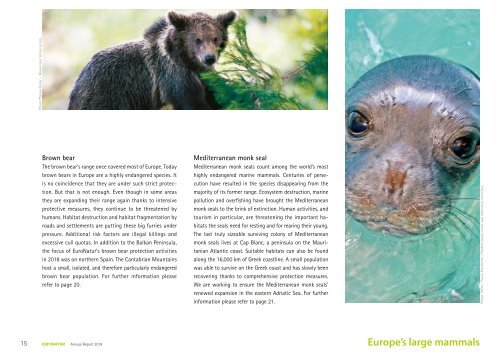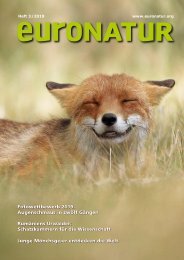Annual Report 2018 EuroNatur Foundation
Here you can get a good overview about our conservation programmes in Europe. Conatains also financial information.
Here you can get a good overview about our conservation programmes in Europe. Conatains also financial information.
Create successful ePaper yourself
Turn your PDF publications into a flip-book with our unique Google optimized e-Paper software.
Photo: Markus Essler - Brown bear (Ursus arctos)<br />
Brown bear<br />
The brown bear’s range once covered most of Europe. Today<br />
brown bears in Europe are a highly endangered species. It<br />
is no coincidence that they are under such strict protection.<br />
But that is not enough. Even though in some areas<br />
they are expanding their range again thanks to intensive<br />
protective measures, they continue to be threatened by<br />
humans. Habitat destruction and habitat fragmentation by<br />
roads and settlements are putting these big furries under<br />
pressure. Additional risk factors are illegal killings and<br />
excessive cull quotas. In addition to the Balkan Peninsula,<br />
the focus of <strong>EuroNatur</strong>’s brown bear protection activities<br />
in <strong>2018</strong> was on northern Spain. The Cantabrian Mountains<br />
host a small, isolated, and therefore particularly endangered<br />
brown bear population. For further information please<br />
refer to page 20.<br />
Mediterranean monk seal<br />
Mediterranean monk seals count among the world’s most<br />
highly endangered marine mammals. Centuries of persecution<br />
have resulted in the species disappearing from the<br />
majority of its former range. Ecosystem destruction, marine<br />
pollution and overfishing have brought the Mediterranean<br />
monk seals to the brink of extinction. Human activities, and<br />
tourism in particular, are threatening the important habitats<br />
the seals need for resting and for rearing their young.<br />
The last truly sizeable surviving colony of Mediterranean<br />
monk seals lives at Cap Blanc, a peninsula on the Mauritanian<br />
Atlantic coast. Suitable habitats can also be found<br />
along the 16,000 km of Greek coastline. A small population<br />
was able to survive on the Greek coast and has slowly been<br />
recovering thanks to comprehensive protection measures.<br />
We are working to ensure the Mediterranean monk seals’<br />
renewed expansion in the eastern Adriatic Sea. For further<br />
information please refer to page 21.<br />
Photo: MOm / Panos Dendrinos - Mediterranean monk seal (Monachus monachus)<br />
15 <strong>Annual</strong> <strong>Report</strong> <strong>2018</strong><br />
Europe’s large mammals





